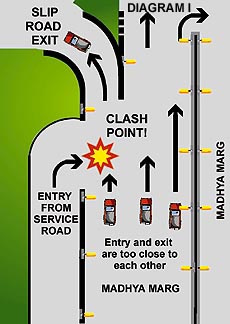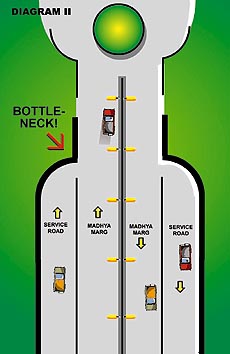What ails
Chandigarh traffic
By H.
Kishie Singh
The entire disease of traffic
— the cause, the symptoms, the remedy — can be
summed up in one word. People.
People create traffic
jams. Not cars. Cars are carelessly handled tools in the
hands of uncaring, foolish and often witless people who
use them as an extension of their aggression and macho
image.
 A car does many things to a person. It
imparts a sense of power. Suddenly the man feels
he’s a bigger person. Just press down with the right
foot and you hear a growl, the sound of unleashed power.
You can’t wait to try it on the road. Oh boy! It
works. The car is fast and nimble. All cars these days
are just that. Soon you learn to overtake from the left
and then zigzag in and out of traffic. What a sense of
achievement and power. See what can I do! A car does many things to a person. It
imparts a sense of power. Suddenly the man feels
he’s a bigger person. Just press down with the right
foot and you hear a growl, the sound of unleashed power.
You can’t wait to try it on the road. Oh boy! It
works. The car is fast and nimble. All cars these days
are just that. Soon you learn to overtake from the left
and then zigzag in and out of traffic. What a sense of
achievement and power. See what can I do!
That’s the way
people behave. People who makes the roads unsafe, people
who create traffic jams.
Doing all the wrong
things for all the wrong reasons.
Chandigarh roads are the
widest, the smoothest, the best lit and are designed to
be user-friendly. However if the user acts in an
unfriendly manner, the road loses its purpose. It becomes
a place of danger. It’s the drivers who must learn
road manners, discipline and safety.
Some roads have changed.
For instance there are no more right turns on Madhya
Marg. With the increase in traffic, a right turn against
on-coming traffic can be most dangerous. It was stopped.
A very wise move.
Chandigarh has the most
beautiful traffic islands—or traffic management
systems. In a well-organised and disciplined society, a
traffic island is usually a dot painted on the road. We
have one in Sector 9. Has anyone noticed it? In organised
traffic, everybody maintains their distance, gives
priority to the right-hand vehicle and traffic. But not
so here. Everyone is in the wrong lane, overtaking on
corners, often on the wrong side, endangering every other
road user. People!
It is not that
Chandigarh roads are absolutely flawless. There are some
who feel that the S bends in the markets have become
hazardous. The rear view mirror does hit a couple of
blind spots and this means you don’t see the
overtaker who sneaks up to you. Pedestrians are
particularly prone to accidents in these areas.
The slip roads are very
good as a concept but as the great Henry Ford once said
"The inlet (entry) should not be so close to the
exhaust (exit)".
Diagram 1 clearly shows
a high danger point. The only solution to this problem is
disciplined driving. Stick to your lane, be courteous,
observe rules and all will be in order.
Signboards are another
strange phenomena in Chandigarh. Signs are meant for
drivers who come from outside . Locals hardly need
directions. So would an outsider be able to decipher
‘Sec, Sect, Univ, PGI. These are excellent examples
of Gulabi English. Moreover, these signs are small in
size and on the roundabouts. Not easy to read while you
are entering a roundabout, fighting traffic for survival.
In any case, the signs are so low and so small that a
scooterist can easily obscure them.
Ever since Madhya Marg
became a "no right-turn road," the signs have
become redundant. They are on the wrong side, impart
incorrect information and serve no purpose. Yet they
continue to be maintained. People have eyes but they see
not. People have heads but they think not!
On the Madhya Marg, the
speed limit is 65 km p.h. A horrifying fast speed for the
most used road in Chandigarh, running through the heart
of the city. People must pay heed to this.
The impact of a
hard-pressed steel and glass projectile travelling at 65
km p.h. on the soft flesh and bone of a human body, more
often than not has fatal results. Why promote this?
There is a strange
syndrome in our country. The person who makes shoes,
wears chappals. He has never heard of arch support. The
tailor who stitches your trousers wears a pyjama and sits
cross-legged on the floor. He has never sat on a chair,
never cocked an ankle on the knee! I suspect that people
who plan and build our roads don’t really use them.
They simply build roads. Design, function and
practicality have no meaning.
 And parking? People just don’t know
the meaning of the word. Sector 17 on a Sunday morning is
a quiet, clean, tranquil place. There are a few people
strolling along and very few cars in sight. And parking? People just don’t know
the meaning of the word. Sector 17 on a Sunday morning is
a quiet, clean, tranquil place. There are a few people
strolling along and very few cars in sight.
Monday morning the cars
come, people driving them. It is here that the
herd-instinct in the India breaks down! Cars are left
facing all directions. Painted lines are ignored. Cars
are parked in the entry-exit points. No attempt is made
at sensible and disciplined parking. Cars are abandoned
helter-skelter. People do these things.
And will craning cars
away be a help? It might be a temporary measure. Indians
are notoriously stubborn and lawless. The minute the
crane is not in evidence, they will go back to their old
ways. Old habits die hard, bad habits die harder.
One reason Chandigarh
has such a high car population is the lack of public
transport. There could be an easy solution to this. It
needs a thought.
Chandigarh must also
have one of the highest cycle-rickshaw population for any
city in the country. I believe the number of licensed
rickshaws is under one thousand. In actual fact there are
12,000 to 15,000 cycle rickshaws in Chandigarh. Organise
them. Chandigarh is a geometrically laid out city. It
should be easy to lay out North-South and East-West
routes. Rickshaws are eco-friendly, non-polluting, silent
and do not leave a heap of manure in their wake! There
will have to be special routes to serve every nook of
every sector.
It will also help the
administration keep track of the rickshawala and his
tribe.
We should keep in mind
that some western cities have opted for the rickshaw as
an alternative to the automobile. In the university city
of Oxford, England, Erica Steinhauser, a young graduate
runs the Oxford Rickshaw Company. Tourists and locals use
rickshaws in Oxford. And they went from India!
We have all this staring
us in the face and people do not know what to do with it.
Some time ago,
Chandigarh experimented with diverting two-wheelers on to
the service road. It didn’t work. What has to be
done is to segregate motorised and non-motorised
vehicles. Any motorised vehicle is capable of 30-35 km
p.h. So set the upper limit at 45-50 and all these
vehicles will move along at a good pace.
The problem starts when
they come up behind a cycle rickshaw, an animal-drawn
cart. The car has to break speed, shift gears. This is
the first symptom of impending traffic congestion and
chaos. Chalk and cheese don’t mix!
A chain is as strong as
its weakest link. Similarly traffic, if mixed, will flow
at the speed of the slowest vehicle. It is not uncommon,
in the city as well as the highway for a fast moving car
to crawl along in the first gear behind a hand-drawn cart
or a cycle rickshaw.
This move is bad from
all points. Firstly, it almost halts traffic. It’s
bad for the brakes, tyre, clutch and worst of all it
ruins the fuel average. For the extra energy required to
move up from first to top gear lowers fuel consumption,
raises fuel bills!
Bottlenecks! Chandigarh
has some excellent examples of how to build a
bottle-neck. In a bottle the liquid is in the bottle and
the neck has been designed to restrict the flow of liquid
from the bottle.
If the same design is
applied to regulate traffic, it will restrict the flow of
traffic. See Diagram 2 for a perfect bottle-neck designed
road — our very own Madhya Marg!
After a high speed run
65 km p.h. is allowed on Madhya Marg, the car will come
to a crawl behind a cart or rickshaw.
This happens at our
roundabouts. And no, the roundabout is not the problem.
Do not start demolishing Chandigarh’s beautiful
roundabouts. Understand and analyse the problem.
Another reason
Chandigarhians are so lucky — only 260 km away, down
NH1 is the best example of the worst traffic disaster. It
is man-made too. The place is Delhi. Soon it will be
faster to walk than drive in Delhi. So what is the need
of the hour? Traffic education that will lead to some
sort of self-imposed discipline and road manners. We need
people who accept social responsibility and are
well-mannered. We need people of this calibre.
Where are they?

|

![]()

